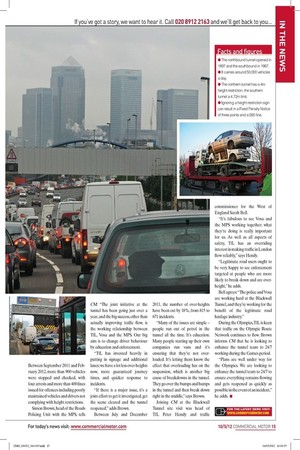Tunnel
Page 10

Page 11

If you've noticed an error in this article please click here to report it so we can fix it.
vision
CM spent a day with the Blackwall Tunnel Metropolitan Police team to see how hard they work to keep traffic flowing and reduce tunnel closures at one of London’s major bottlenecks
By Laura Hailstone
THE BLACKWALL Tunnel is a notorious traffic hotspot. Linking east and south London, the 115year-old tunnel under the River Thames is often responsible for huge tailbacks. For every minute that the tunnel is closed, up to 60 vehicles are prevented from travelling through.
According to Transport for London (TfL), the main reason for tunnel closures is over-height vehicles: the northbound tunnel has a height restriction of 4m, while the southbound tunnel is 4.72m.
In 2010, the tunnel was closed 1,604 times with 70% of those closures due to lorry drivers ignoring the height restriction warning signs. Vehicle breakdowns are also a big problem, responsible for 287 closures in 2010; a third of which were due to vehicles running out of fuel.
In response, TfL is funding a joint initiative between the Metropolitan Police Service (MPS) and Vosa, which has seen officers from the MPS Safer Transport Command Roads Policing Unit based permanently at the tunnel since September 2011. The team of 10 officers provides an immediate response to incidents occurring in or around the tunnel. As a result, during the six months to February 2012, the average time taken to deal with each accident dropped by 50% year-on-year, from over 35 minutes to around 16 minutes.
Rapid response
On the crisp morning that CM joins the tunnel team, it’s not long before constable David Morgan and sergeant Russ Segalov are alerted to an over-height foreign truck that has been diverted away from the tunnel and along the new overheight vehicle detection lane.
Since the over-height LGV divert went live in November 2011, more than 800 vehicles have been diverted away from the tunnel.
Negotiating the late morning traffic, the officers’ 4x4 soon reaches the divert lane, and the over-height vehicle is released through the barrier to a safe place to park.
The officers explain to the driver the reason why his truck was directed away from entering the tunnel. Like many foreign drivers the officers encounter, he appears oblivious to the height restriction. They explain, using a map, the best way for him to get across the river and onwards to his destination, avoiding the tunnel completely.
Morgan and Segalov tell CM this is a common scenario.
“As they approach the northbound tunnel on the A12 there are two opportunities for them to realise they will be too tall for the tunnel,” explains Morgan.
Since November, the approach to the tunnel on the A102 has been changed to retain two lanes of general traffic, with the existing nearside lane for use by vehicles taller than 2.8m and local traffic.
“Vehicles passing the gauge will be allowed to proceed through the tunnel if lower than the permitted height of 4m. Over-height vehicles will be diverted away from the tunnel, along Tunnel Avenue to continue their journey via the M25 as we point out on the map to them,” says Morgan.
Enforcement
In conjunction with Vosa, the tunnel police team also carries out enforcement operations and stopchecks on vehicles to help prevent incidents occurring in the first place. Between September 2011 and February 2012, more than 900 vehicles were stopped and checked, with four arrests and more than 400 fines issued for offences including poorly maintained vehicles and drivers not complying with height restrictions.
Simon Brown, head of the Roads Policing Unit with the MPS, tells CM: “The joint initiative at the tunnel has been going just over a year, and the big success, other than actually improving traffic flow, is the working relationship between TfL, Vosa and the MPS. Our big aim is to change driver behaviour by education and enforcement.
“TfL has invested heavily in putting in signage and additional lanes; we have a lot less over-heights now, more guaranteed journey times, and quicker response to incidents.
“If there is a major issue, it’s a joint effort to get it investigated, get the scene cleared and the tunnel reopened,” adds Brown.
Between July and December 2011, the number of over-heights have been cut by 18%, from 815 to 671 incidents.
“Many of the issues are simple – people run out of petrol in the tunnel all the time. It’s education. Many people starting up their own companies run vans and it’s ensuring that they’re not overloaded. It’s letting them know the effect that overloading has on the suspension, which is another big cause of breakdowns in the tunnel. They go over the bumps and humps in the tunnel and then break down right in the middle,” says Brown.
Joining CM at the Blackwall Tunnel site visit was head of TfL Peter Hendy and traffic commissioner for the West of England Sarah Bell.
“It’s fabulous to see Vosa and the MPS working together; what they’re doing is really important for us. As well as all aspects of safety, TfL has an overriding interest in making traffic in London flow reliably,” says Hendy.
“Legitimate road users ought to be very happy to see enforcement targeted at people who are more likely to break down and are overheight,” he adds.
Bell agrees: “The police and Vosa are working hard at the Blackwall Tunnel, and they’re working for the benefit of the legitimate road haulage industry.” During the Olympics, TfL is keen that traffic on the Olympic Route Network continues to flow. Brown informs CM that he is looking to enhance the tunnel team to 24/7 working during the Games period.
“Plans are well under way for the Olympics. We are looking to enhance the tunnel team to 24/7 to ensure everything remains flowing and gets reopened as quickly as possible in the event of an incident,” he adds. n












































